School libraries evolve to engage; Changes draw in technology and more
Published 8:08 am Friday, October 20, 2017
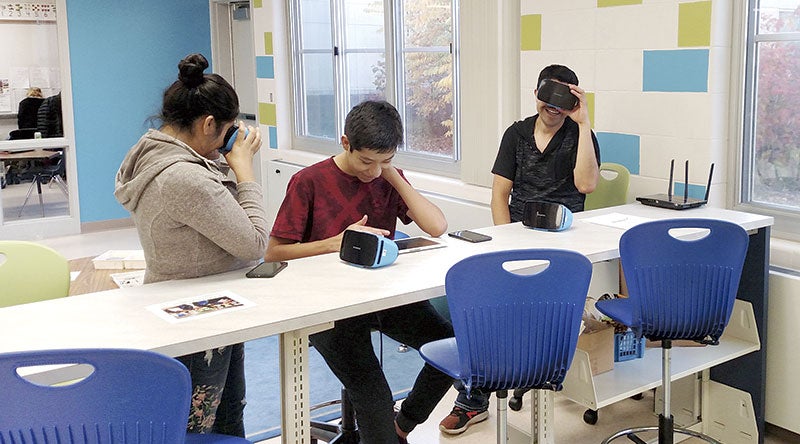
- A family makes use of the technology available to students in the newly modified Southgate Elementary School library. Eric Johnson/photodesk@austindailyherald.com
Author and poet Stuart Dybek said once that a library is “where place and possibility meet.”
However, educators from two of Austin’s public schools might amend that by saying libraries are a place where space and possibility meet.
Creating learning spaces is something of a buzz phrase in school classrooms these days, but few would include libraries as being part of that space.
For years, school libraries have looked pretty much the same: A circulation desk, desks at which to sit and shelves of books — lots of books.
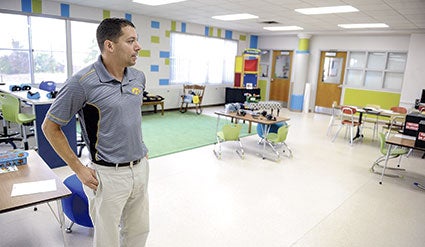
Jer Osgood, a technology integrationist at Southgate Elementary, shows off the repurposed library space Wednesday morning at the school. Eric Johnson/photodesk@austindailyherald.com
And, if you were lucky enough to have some technology in the library, it probably was considered something you had to find space for, rather than making it a highlight.
Jer Osgood, the technology integrationist at Southgate Elementary School, said staff got together last year to decide that “we wanted to create a space that would be more friendly. Still, focused on literacy, but a place for kids to explore, to spark their imagination.”
With the help of teachers, staff and grant funding from the Parent Teacher Council and the Austin Public Education Foundation, the Southgate library has been renovated and its space redesigned to become a more open and airy place — still filled with lots of books, but a lot of other things, too: flexible and more comfortable seating, brightly-painted walls, with technology as seamlessly a part of the space as books are.
There are puppets and a puppet theater, a green screen (used in video production) and Legos to engage creative thinkers. The high school recently lent visual reality devices so students could more vividly see countries they had read about. There are craft tables and audio devices to jointly listen to stories, and the list goes on.
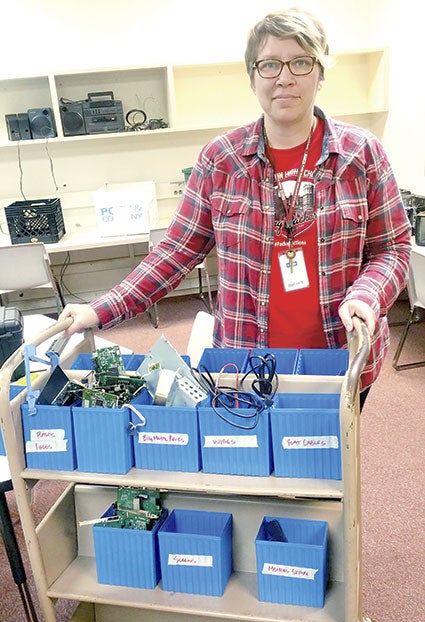
Austin High School Technology Integrationist Amy Thuesen says one space in the library is now dedicated to “Break and Make,” an activity that allows students to break apart old electronics and create something new with them.
Deb Nicklay/deb.nicklay@austindailyherald.com
Fourth-grade instructor Ryan Timm said the new space “is really comfortable … and the kids are really engaged” when they visit the library. The seating accommodations for students is varied from rocking chairs and high-tops, to short, flexible seating (think exercise balls with legs) and sitting on the new, colorful mats. Timm said he sometimes provides camp chairs during nice weather, so students can sit outside and read in the adjacent courtyard.
“There are kids at every station when we go to the library,” he said, adding there are not only books to trigger the imagination, but tools to recreate ideas in different ways. One of his students, he said, is making a (clay animation) video to demonstrate one chapter out of a book he was reading, using characters made of Legos, instead of the traditional clay.
Principal Katie Baskin applauded those who created the new space that “creates great opportunities to dive in and collaborate. I am so excited to see our kids so engaged in learning … so ready to dig into books.”
First-grade teacher Brenda May called it “a wonderful space for students” that provides comfort.
“They love going there, and finding a cozy, comfy spot to enjoy their book,” she said.
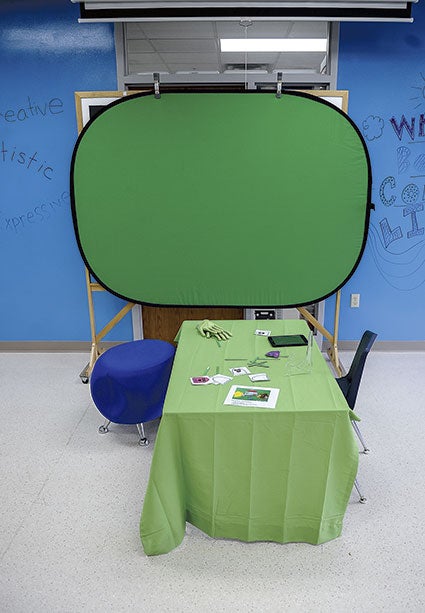
A green screen in the Southgate Elementary School library allows students to interact in a virtual space for things like puppet shows. Eric Johnson/photodesk@austindailyherald.com
Southgate is not alone. Amy Thuesen, the technology integrationist at the high school worked with instructional coach Alexa Dolan Peterson and media technician Anne Christopherson to create new spaces in the media center, too. They had surveyed students last year to find out what they wanted in their library. They found students wanted quiet spaces, and places to work in small groups,
“They also said they found the library kind of blah,” she said.
Staff got to work, following some of the same principles as those used at Southgate. Both schools purged their libraries of books that had many duplicates, or were no longer accurate in terms of geography and history. Both schools moved its shelving to allow for creation of open spaces that provided more comfortable seating.
As was the case at Southgate, the high school gave its library a fresh coat of paint to create interest.
“All the walls were cream-colored, every one,” Thuesen said, chuckling.
Staff also realigned the books to be classified by genre, instead of the traditional subject/author format.
“I have kids who say, ‘Where did those books come from?’” Thuesen said. “They don’t realize that there were here all the time.”
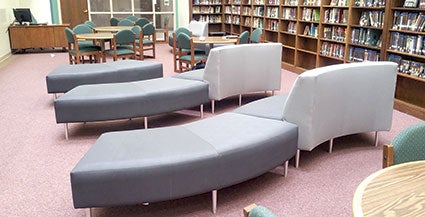
The high school media center has been redesigned, using shelving and furniture already on hand. Some of this furniture was formerly in the commons area; shelving has been rearranged, and books are now found by genre. Some students have wondered “where the new books came from,” when, in fact, they were always in the library. Other books have been purged — some of them too old to be accurate any longer — and the others reshelved. Deb Nicklay/deb.nicklay@austindailyherald.com
The video production area, once housed in the center, was moved to larger classroom quarters due to the popularity of the class, Thuesen said. As a result, other spaces sprang up, from a makerspace that hosts a 3D printer, where students design inventions and are able to print them; to a “Break and Make” area, where students take old electronic parts and remake them into new artistic creations.
There is also a “Brain Break” area, where students can escape from a heavy academic day, “but still have something that can engage their brains,” such as Sudoku and jigsaw puzzles. And, there are still tables and quiet spaces, where students can spread out homework.
“Overall, we’re really trying to provide more choices with learning, that school is more than the classrooms,” she said.
Technology is still considered a support, rather than a focus. The high school library also has a “Tech Cafe” where students come for tech support. There is also a charging area for devices.
At both Southgate and at AHS, modifications were made with little money, but with lots of staff labor. A former bookshelf at the Southgate library, for instance, was de-shelved and repurposed to become a high top table where students can do projects; at the high school, some shelving units were made to become modular and backed with Smart-like board material — similar material was used in the Southgate library. “New” seating at the high school library came from the school’s commons area.
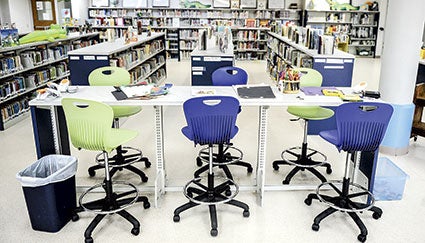
The tables in the Southgate Elementary School have been adjusted to better accomidate the students using them. Eric Johnson/photodesk@austindailyherald.com
In both libraries, the changes were made with low budgets in mind, and with the help of staff and teachers who recognized the need and were inspired by the results.
And, of course, as were the students.
Thuesen was surprised one day, when she saw two teens working together in the “Break and Make” area.
“One is a real mechanic; the other, I guess you could say, a bit more cerebral,” she said. “But there they were, clunking away together, talking and trying different things — which might not have happened at all, otherwise.”





